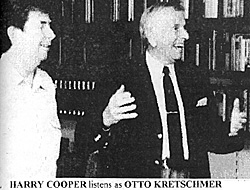The experiences made during the Norwegian Campaign led to the order by U-Boat Command to change from magnetic to impact fuse. Furthermore, the trial procedure for the torpedoes was critically tested by a special commission with the not surprising result that they ran almost three meters deeper than set. This had been known and accepted secretly in peace time because the torpedoes with their magnetic fusing were meant to pass underneath the target anyhow.
Now the order was issued: Depth setting as shallow as possible. Less than three meters let the torpedo break the surface. All escort vessels up to destroyer size were safe now and after a short while they knew it.
But soon another setback became rather apparent. The hitting angle had to be almost 90 degrees because the gripping appliance at the forefront of the warhead had been minimized by the designers to a tiny ornament of only emotional value which could not prevent the torpedo from sliding away from the side of the target when the angle of hitting differed too much from a right angle. The reason was again, the magnetic fuse which had led the designers to have ideas of their own.
 HARRY COOPER listens as OTTO KRETSCHMER explains tactics. July, 1994 in the KRETSCHMER home.
HARRY COOPER listens as OTTO KRETSCHMER explains tactics. July, 1994 in the KRETSCHMER home.
The change seemed to me as very important after I had seen one of my torpedoes appear on the surface at a ship's side. But another drawback not to be cured was the impossibility of a shallow set torpedo to keep the set depth when running against an already moderate swell. It would break the surface at peculiar places away from its set course.
Another beastly quality of our HAPPY TIME torpedo was its inclination for circle running. Every time I fired a torpedo, I had the operator of the underwater listening devise report constantly the behavior of our precious 'eel'.
Frauenheim, Captain of U-101, had told me that his 8.8 cm gun was hit once, fortunately by a trial torpedo. It is suspected that of the number of the submarine losses by unknown reasons during the earliest part of the war, quite a number might be credited to circle runners.
U-47 SUNK BY CIRCULAR RUN
Last year the Historical Division of the Navy found out that the story of HMS WOLVERINE and U-47 (GŁnther Prien) told in many history publications had to be revised. A comparison of war diaries of ships of both sides engaged with Convoy OB.293 showed that WOLVERINE had constantly attacked UA (Eckermann) which had to leave the battlefield on account of heavy damage. I remember that Eckermann made a signal to that effect, and that Prien's shadowing signals terminated and were not taken up again. WOLVERINE reported, as I was told after my capture, a heavy underwater explosion with a bright orange light clearly discernible in the dark night. It is generally believed that this was the end of U-47 inflicted by a circle runner of one of her own HAPPY TIME torpedoes.
Many thanks to OTTO KRETSCHMER for this great insight into what really was going on during World War II. How many US Navy submariners can draw a parallel to the problems of magnetic exploders that didn't work; of impact detonators that failed unless the target was hit in a precise way; and too familiar with circular running fish. USS TANG (SS 306) under command of RICHARD O'KANE(1450-+-1990) was lost in that same way.
Back to KTB #111 Table of Contents
Back to KTB List of Issues
Back to MagWeb Master Magazine List
© Copyright 1995 by Harry Cooper, Sharkhunters International, Inc.
This article appears in MagWeb (Magazine Web) on the Internet World Wide Web. Other military history articles and gaming articles are available at http://www.magweb.com
Sharkhunters International, Inc., PO Box 1539, Hernando, FL 34442, ph: 352-637-2917, fax: 352-637-6289, e-m: sharkhunters@hitter.net
